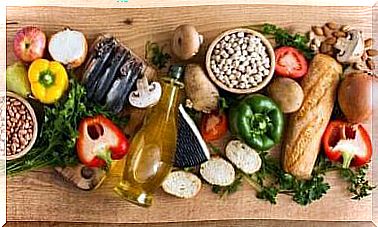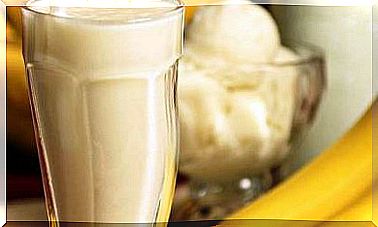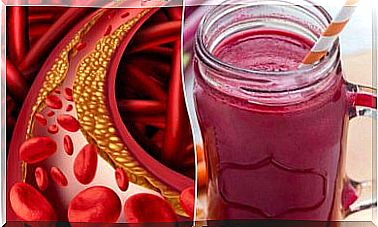What Are The Types Of Food Additives Out There?

Today we are going to talk about the different types of food additives. Food additives are a series of substances that the food industry uses to improve the properties of food or to improve its preservation.
While most of them are safe for health, a number of them spark debate among the experts. Before we start, you should know that there are different types of food additives, so they are classified into groups.
Some are harmless to the body or even beneficial. This is the case with gelling agents. However, others are controversial for their effects on the gut microbiota. In this case we are talking about sweeteners.
Types of Food Additives
In this article, we discuss the main categories of food additives used in the food industry and the effects they can have on human health.
1. Types of Food Additives: Preservatives

Preservatives are substances that manage to reduce the microbiological risk of foods and thus extend their shelf life. Many of them are harmless to humans because we do not metabolize or absorb them at the gut level.
However, one of the most common types of food additives, nitrites, increases the incidence of a number of cancers. Research published in the journal Nutrients provides evidence for this claim.
The meat industry uses these preservatives and they are the main reason why experts discourage the consumption of processed red meat. This type of food is associated, among other things, with a poorer health condition due to the presence of nitrites.
2. Fragrance Enhancers
Fragrance enhancers are substances that, as their name suggests, are responsible for altering or amplifying the smell of food. In general, they are harmless to health, apart from some intestinal disturbance that you may experience as a result of overconsumption.
The most common in these situations is diarrhea. In the long run, however, odor enhancers are not harmful, or at least the scientific literature has yet to provide some evidence that they are.
3. Types of Food Additives: Colorants
These kinds of food additives are used to give color. Certain dyes have been banned because of their relationship to the appearance of some types of cancer (Spanish link).
Today, however, the food industry uses a lot of pigments to impart flavour. These pigments not only have no negative effects, but also help prevent the development of diseases.
A clear case are the anthocyanins, they are responsible for the color of blueberries and are able to exert an antioxidant effect. This is according to a study published in Critical Reviews in Food Science and Nutrition.
When reading food labels, it is important to pay attention to the indication of food additives. If natural colors (especially plant phytonutrients) are used, then you should not consider the product to be harmful unless another ingredient in the formulation specifies otherwise.
4. Sweeteners
This group is the most controversial among nutritionists. Sweeteners are substances with a sweetening power that replace sugars. However, the experts disagree on whether or not they are much better than sugar itself. In this group, saccharin, stevia, sucralose and aspartame stand out.
A number of people claim that our bodies do not metabolize many of these chemicals at the gut level. However, most studies show negative effects on the intestinal flora. Indeed, the results cannot be directly extrapolated, but it is also true that there are no long-term studies to confirm their safety.
5. Flavor Enhancers
Flavor enhancers include a range of food additives that improve the organoleptic properties of food products. One of the most important of these is monosodium glutamate (Spanish link), which is responsible for the recently identified umami taste and is especially present in Eastern cuisine.
Many industrial products contain these types of food additives, as they manage to improve the acceptance of foods and increase their palatability. They are not a priori harmful to health. However, be careful with excessive doses of salt.
6. Stabilizers, Gelling Agents, Emulsifiers

These types of food additives are responsible for improving the texture of food. They have no negative effects on the human organism, but rather the opposite.
Some of the products that fall into this category have properties that stimulate the gut microbiota and improve its functions. This is the case, for example, with agar-agar.
The regular consumption of this class of gelling agents provides a gut-level fermentation that promotes the growth of the bacteria that colonize the gut.
This process can improve nutrient metabolism, reducing the risk of obesity and metabolic diseases. Research published in the journal Gut Microbes provides the same evidence.
7. Modified Starches
Starches stand out as they are used in bakery products to impart better elastic properties to food and dough. They consist of a mixture of polysaccharides, making them carbohydrates. By themselves, they are not harmful to the body.
For individuals with a sedentary lifestyle, excessive dietary carbohydrate intake is not beneficial. This is not the case for athletes, who must meet their carbohydrate needs to replenish the glycogen stores they use during exercise.
However, subjecting modified starch to high temperatures produces various toxic waste products, such as acrylamide (Spanish link). Research has shown that these are harmful to health.
8. Acidifying Agents
The food industry also uses acidifying agents to enhance the taste of food. Sodium sulfate and potassium sulfate are the most important. They do not cause any unwanted effects in the body, as long as you do not exceed the prescribed doses.
Otherwise, they could cause a significant laxative symptom. This happens, for example, when someone has consumed too much candy or chewing gum.
9. With enzymes
Enzymes are typical for foods for people with intolerances or for products generated by the dietary supplement industry. The most common case is that of patients with lactose intolerance, as the presence of the enzyme lactase helps them metabolize this sugar.
It is also common to find protein isolates or concentrates with digestive enzymes to improve the digestion of nutrients and prevent the formation of gas. Enzymes are not harmful to health and experts consider their use to be safe.
10. Antioxidants
Antioxidants are food additives that block or slow the oxidation of foods, extending shelf life. This function is performed, for example, by ascorbic acid (vitamin C).
Its use prevents the rancidity of fruits, such as avocado or apple. Its inclusion in the diet also has a positive influence on the functioning of the immune system. It has even been shown that increasing the intake of vitamin C reduces the duration of a cold.
General functions of food additives
Now we will look at the main functions of food additives so that you will understand why they are so commonly used in the food industry.
They preserve the nutritional value of foods
Many of the substances used by the food industry are intended to preserve the nutritional value of products. In this way, avoiding oxidation allows for greater preservation of vitamins by reducing their contact with oxygen.
They preserve the health of the food
Preservatives succeed in extending the shelf life of food, improving its preservation and reducing the risk of contamination with microorganisms. In this way, they protect our health by reducing the risk of poisoning.
They ensure the pH balance in foods and ensure fermentation
Many of the food additives used by the food industry manage to ensure the acid-base balance of products, which means they are better preserved. Gelling agents or stabilizers can also lead to a more efficient fermentation, giving foodstuffs added value thanks to the proliferation of beneficial bacteria.
They add more color and flavor to the food
This is one of the reasons the food industry uses additives. Due to the fact that they improve the organoleptic properties of food, they manage to significantly increase sales.
And this in turn has a positive impact on companies. However, it is necessary to ensure that this does not pose a risk to human health…something that does not always happen.
They improve the texture and consistency of food

You’ve probably wondered why the texture of ultra-processed products is always perfect and different from homemade products. It is undoubtedly due to the presence of food additives in their composition.
This kind of substance manages to squeeze the ingredients together and give the mixtures a greater spongy or sticky feel, which affects your experience when tasting them.
Food Additive Side Effects
Although food additives have a field of application and a specific purpose, they are not always safe for your health. Especially in the case of overuse, because they cause a series of side effects. It is therefore not recommended to take them in large quantities.
It is important to be careful with preservatives such as nitrites and artificial sweeteners (Spanish link). The latter is able to induce changes in the populations of bacteria living in the gut, affecting nutrient metabolism and digestion.
Food additives: they are almost always present
It is important to note that food additives are present in almost every diet these days. Avoiding their consumption is difficult and perhaps it would not even be advisable if it were possible. It is important to moderate their intake, although not always in the same way.
Remember that the basis of a healthy diet is variety and the predominance of fresh products as opposed to ultra-processed products. It must also be balanced from a caloric point of view to avoid weight gain.









